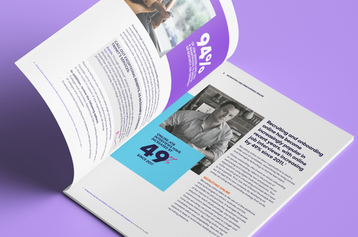Burnout vs Languish: How it Impacts You & Your Employees

Table of contents
- 1.6 Ways to Identify Burnout in Your Top Performers
- 2.Burnout: a medical illness and mental health concern
- 3.How burnout affects different types of employees
- 4.Employee burnout signs
- 5.Detachment from the workplace culture
- 6.Decreased productivity
- 7.High turnover rates
- 8.Increased absenteeism
- 9.Low customer service ratings
- 10.Irritability and heightened sensitivity to feedback
- 11.3 Signs You Might Be Experiencing Burnout
- 12.Exhaustion
- 13.Lack of creativity and motivation
- 14.Changes in self-esteem
- 15.What to do if you’re feeling burned out?
- 16.Reprioritize your work
- 17.Identify and repair unhelpful thought patterns
- 18.Take care of your mind, body, and soul
- 19.Languish: What It Is, and How to Help Employees Experiencing It
- 20.If you’re noticing a dip in your employees’ ability to focus and find motivation, they may be feeling languish
- 21.Name the feeling: languish
- 22.Create time for uninterrupted work
- 23.Set small and achievable goals
- 24.Promote the importance of time off
Employee burnout and languish are two very real concerns for any business owner or HR department. While the causes can vary, such as a sudden spike in demand for services, pinpointing the issues and identifying ways to address them can provide significant value in the long term.
6 Ways to Identify Burnout in Your Top Performers
Employee burnout is a growing concern that can poison your workforce. Here’s how to spot it early.
The concept of employee burnout is not new. However, with the COVID-19 pandemic, it has become more rampant than ever. The pandemic has had a drastic effect on the entire populace, and employees are no exception. It has put a strain on the physical, mental, and emotional capacities of workers. Levels of employee burnout are at an all-time high, according to the 2021 Work and Well-Being Survey conducted by the American Psychological Association.
Workplace burnout is characterized by a state of excessive physical and emotional weariness that leads to a loss of professional competence, increasing cynicism, a lack of engagement, and a lack of energy. According to a Deloitte workplace burnout survey, over 70% of employees say they’re burned out and feel that their bosses aren’t doing nearly enough to help them deal with it.
The top performers in your organization are usually the most efficient and effective workers you have. Given the harsh realities of the pandemic, companies have realized that this is no time to lose their best hands, and many businesses have responded by expanding their benefits packages. But, more specifically, high-quality, science-based mental healthcare for employees is now essential to attracting, recruiting, and retaining top talent.
Burnout: a medical illness and mental health concern
Workplace burnout was recognized by the World Health Organization (WHO) in 2019 as a medical illness that can also be classified as a mental health concern. Since there is still a stigma associated with mental illnesses in and around the workplace, many employees are hesitant to tell their boss about their struggles with burnout and mental health. As a result, they shoulder the responsibility on their own, resulting in fast declines in productivity, performance, happiness, and mental health. Employees who are very stressed will likely have a harder time regulating emotions like anger and sadness — which can result in outbursts and substance abuse.
It’s critical to create a culture that’s supportive of employees with mental health needs. Directly saying — and continually reminding — your company that you see mental health as important and necessary can make a significant impact. Management and company leaders should reinforce the same messaging.
How burnout affects different types of employees
Employees can experience burnout at any time and at any stage of their careers. It makes no difference if they’ve worked for the company for 6 weeks, months, or years. Even the most intrinsically driven individuals are susceptible to burnout. According to Deloitte’s survey, 87% of employees are passionate about their jobs, but 64% are frequently stressed. This goes to show that regardless of the personality of the employees, burnout affects them all in similar ways.
However, employee burnout is more likely to occur when they are no longer invested in their jobs. When there’s a loss of drive or the will to work, and the employee no longer buys into the mission and vision statements of the organization, then it would be very easy for such an employee to be burned out. And the low energy levels of a burned-out employee can affect workplace morale and the productivity of others.
For self-driven employees who love their jobs, burnout can build up over time. The struggle to adequately manage work, life, and the mental pressure created by the pandemic, for example, could lead to these feelings. With this group, burnout could take years to develop, especially if it is not addressed. Self-motivated employees often work harder and for longer periods while taking fewer breaks. This could result in burnout in the long run.
Employee burnout signs
It is managers’ job to notice changes in employees’ behavior and signs of burnout.
There are several indicators to look out for. If you see any of your employees exhibiting one or more of these 6 signs, they’re likely suffering from burnout.
1. Detachment from the workplace culture
Even if a burned-out employee attends meetings and events, they are not present. Their lack of participation and contribution demonstrates this. This is especially noticeable if such employees used to be actively involved in workplace activities. A sudden or even subtle change in this regard could mean they are getting burned out. This is why managers need to know their staff, so when changes like this occur, they notice it immediately.
2. Decreased productivity
When a top-performing employee begins to miss deadlines and displays a sharp decrease in productivity, burnout has probably set in. Decreased productivity would mean a corresponding decrease in customer satisfaction. Coming from your top performers, this could be really bad for your organization.
3. High turnover rates
Higher staff turnover and attrition rates, as well as employees leaving the company more quickly, can lead to a shortage of talent as well as higher overall recruiting costs. When you notice that the turnover rates are high, it is time to look inwards and check if you’re not burning your employees out.
4. Increased absenteeism
When your top employees begin to call in sick more often than not, then they may be getting burned out. Stress builds up over time, and when it gets to a certain level, even the strongest will cave in. Be vigilant. When top employees take frequent sick leaves, come in late, and are not as productive as they usually are, they are likely exhibiting signs of job exhaustion.
5. Low customer service ratings
If you notice a sudden dip in the customer satisfaction ratings, you need to check your employees and make sure they’re not being burned out. Beyond your employees, your customers are the most important part of your business. An efficient workforce equals happy customers, and an exhausted workforce equals unhappy customers. Burnout could be the reason your customer service rankings have been declining. It’s possible that your employees aren’t approaching or responding to clients in a pleasant manner.
6. Irritability and heightened sensitivity to feedback
The importance of feedback cannot be overstated. It gives employees an assessment of what they are doing right or wrong. It involves acknowledging them for the things they’re doing right and also dishing out criticism where necessary. If you begin to notice your top employees having an irritable or sensitive demeanor during performance reviews or feedback sessions, they may be stressed out.
Your employees are the backbone of your organization. They are the face of your business as they come into direct contact with your customers. To maintain efficiency and ensure productivity, you have to keep your employees, especially top performers, in tip-top shape. Employee burnout can be challenging, so be on guard and be ready to step in the moment you notice any of the aforementioned signs.
3 Signs You Might Be Experiencing Burnout
Learning to exist in this new COVID-19 world can cause mental exhaustion with your work and personal life. Here are signs to look for which may indicate you’re burning out and need to switch gears.
Here's what you need to know:
- Burnout can be characterized by feelings of exhaustion or depletion, increased mental distance from work, feelings of negativity related to a job, and reduced professional efficacy
- Chronic exhaustion presents itself as a common symptom amongst many people experiencing burnout
- Another symptom of burnout can be a lack of creativity or motivation for the things you once enjoyed
- Experiencing feelings of burnout can negatively impact one’s self-esteem
To those feeling burned out: reprioritize your work, identify and repair unhelpful thought patterns, and take care of your mind, body, and soul
In our regular life, there exist many common factors which can cause us to feel burned out. The pressures from managing our day-to-day job or running our business can be challenging to juggle under regular circumstances.
According to the World Health Organization, burnout can be characterized by feelings of exhaustion or depletion, increased mental distance from one’s job, feelings of negativity related to a job, and reduced professional efficacy.
As COVID-19 continues to impact all areas of our lives, it’s important that we each reflect inwards and assess our own relationship with burnout. We may be struggling with questions like “How do I work while staying sane at home? How do I manage the expectations from my family and business at the same time?” We may be at risk of experiencing burnout in a whole new way.
In order to take care of yourself, there are clear signs to look for which can indicate that you’re heading for a burnout and need to change gears. Here are 3 which we will discuss.
Exhaustion
Chronic exhaustion presents itself as a common symptom amongst many people experiencing burnout.
Arielle Shnaidman, Business & Mindset Coach describes her experience with burnout and says the most red flag symptom for her was “feeling exhausted before even starting my workday.”
Where we typically experience burnout due to long days, demanding deadlines, or frustration with our role, we’re now experiencing a whole new theme of exhaustion during this pandemic.
Learning to exist in this new COVID-19 world can cause a lot of mental exhaustion. Many of us are dealing with the realities of not being able to enjoy our everyday work routines. We are also being challenged to work from home with partners, families, or in isolation. Coupled with the constant influx of negative media, it can be exhausting for just about anyone.
To combat this exhaustion, find hobbies, activities, and routines that you enjoy. Remember that what works for one person might not work for the other. Give yourself a mental and physical break, and find enjoyment in activities outside of work.
Lack of creativity and motivation
Another symptom of burnout can present itself as a lack of creativity or motivation for the things you once enjoyed.
Samantha Lloyd, Co-founder and CEO of Metaranx shares her experience with burnout when working throughout corporate jobs and says, “When you’re engaged with your work, you’re constantly thinking about ways to do more and new methods to improve an aspect of your job, your team, and your goals. When you’re burnt out you lose that motivation to think outside the box and look for new ideas.”
If you’re an extrovert, your motivation and energy may come from being around people in the office. For these individuals, living in isolation and working from home may be hindering your current motivation.
Nicholas Bloom, economics professor at Stanford recommends recreating the social interactions you would have face-to-face over video conference as much as possible. There are tons of ways to create space for socializing virtually, including virtual coffee chats, virtual lunches, or even team trivia!
Changes in self-esteem
Experiencing feelings of burnout can negatively impact one’s self-esteem.
Shnaidman shares that when she had burnout, it caused her to have self-doubt. She says that, “When you’re really burned out you can’t think as creatively or strategically and you start to doubt yourself and your abilities. This then feeds into imposter syndrome, which pushes you to work even more, trying to figure out how to not get ‘found out’ as an imposter, leading to more anxiety and burnout — it’s a vicious cycle.”
Many people may be questioning whether they are doing a good enough job taking care of their families, businesses, or employees. Remember that we’re all in this together. It’s imperative to speak kindly to yourself and avoid adding more pressure to your plate.
What to do if you’re feeling burned out?
Reprioritize your work
Lloyd says “I try my best to divide tasks into smaller chunks to make them seem less daunting or overwhelming. I also prioritize certain projects over others. I learned to work effectively so that I didn’t have to turn down projects that excite me.”
Use this time to reflect on your workflows, processes, and systems to evaluate what is and isn’t working for you.
Identify and repair unhelpful thought patterns
Shnaidman says, “The hours we put into work only account for a fraction of actual burnout. It’s also all the time we spend thinking about work that leads to burnout. You might work a normal 40 hour week, but I guarantee a lot of people spend at minimum 20 hours a week thinking about work, which is exhausting.”
Addressing burnout begins with addressing your thoughts. Fear, anxiety, and shame are heavy emotions and they’re a result of the things you say to yourself, says Shnaidman.
If you need some ideas for becoming more mindful with your thoughts, consider using this time to develop a mindfulness practice.
Take care of your mind, body, and soul
Lloyd says, “The main things that keep me from burning out are sleeping well, eating well, and setting aside time for social and fun activities. If you’re feeling burned out, especially if it’s over a business you run, then you need to take time to focus on yourself. Your business cannot successfully operate if you’re not at your best.”
Shnaidman says, “You’re in this for the long haul so you need to learn to manage your mind. Look for something in your work or life that you enjoy right now. Maybe it’s the flexibility of your schedule, the freedom to work from home, or the ability to work on something you’re passionate about — the point is to find something you currently enjoy right now and then celebrate the hell out of it. This helps you to start training your brain to think positive thoughts so you can feel more energized.”
Languish: What It Is, and How to Help Employees Experiencing It
The feeling of languishing is on the rise, thanks to COVID-19. Here’s the antidote for it.
If you’re noticing a dip in your employees’ ability to focus and find motivation, they may be feeling languish
According to Organizational Psychologist Adam Grant, languishing is “a sense of stagnation and emptiness. It feels as if you’re muddling through your days, looking at your life through a foggy windshield.” In his New York Times piece titled “Feeling Blah During the Pandemic? It’s Called Languishing,” Grant explains that this will likely be the dominant emotion of 2021 as the pandemic continues.
If you’re managing a team or running a small business, it’s possible that your employees at this time may be experiencing languish too. This could mean that they are not functioning at their full capacity and their ability to focus and find motivation may be dulled.
In the above mentioned article, Grant explains that the antidote to languishing is to get into a state of flow, where people can experience a meaningful challenge and get lost in whatever it is they are doing. Let’s discuss how you can help your team from languishing and get them into their flow state.
Name the feeling: languish
One of the quickest ways to reduce the negative charge of an emotion is to name it as it bubbles up. This could sound as simple as responding “I’m feeling a lot of languish today” when someone asks you how you’re doing.
By giving a name to the emotion of languish, people understand that what they are going through is normal and should not be internalized. They will learn to attribute the feeling to the external circumstances experienced through this pandemic.
If your team has not yet read Grant’s article, share it through Slack or email, and let them know you are open to discussing the topic. You could also hold a team meeting and discuss ideas for how people are getting through their own sense of languish, sharing tips and best practices to help them get through it.
Create time for uninterrupted work
Grant suggests that leaving time for uninterrupted work can help people get back into their sense of “flow.” You can help by reducing the amount of meetings people need to attend, as this can also cause interruption to focus. Encourage your team to block out an entire day on their calendar to do deep work and decline meetings. Or, have them block out the time on their calendars where they know they are the most productive as a “no meeting” time.
It’s also helpful to do work that requires your full attention. For example, leading a workshop for your team or attending a webinar that requires participation can be a good way to create focus.
Set small and achievable goals
Having a set of small goals to accomplish each day can help your team feel like they are making progress. Small goals can be work tasks that may not be very hard or important, but will have impact nonetheless. For example, you can update your team drive, or do a content review of some material. Though not hard, it can be an easy goal for someone to pick up and feel accomplished when complete.
You can also encourage your team to set personal goals like “meditate for 10 minutes each day” or “ go for a 15 minute walk on your lunch.” Encourage them to carve out time in their calendar each day to work on something that excites them and positively impacts their wellbeing.
Promote the importance of time off
If your company is in a position to allow personal days and time off, encourage your team to take mental health days. Allowing people to recharge will help them feel better, and come back more energized. Lead by example and take time off as well so your team knows it’s safe to follow suit.
Encourage strong boundaries with your employees by logging off after work and letting them do the same.
According to Grant’s article, extended amounts of languish can be the precursor for future depression and anxiety. Whether you’re just returning to the office, still working from home, or have been on the frontline throughout the pandemic, the feeling of languish is real and should not be ignored.

TriNet Team
Table of contents
- 1.6 Ways to Identify Burnout in Your Top Performers
- 2.Burnout: a medical illness and mental health concern
- 3.How burnout affects different types of employees
- 4.Employee burnout signs
- 5.Detachment from the workplace culture
- 6.Decreased productivity
- 7.High turnover rates
- 8.Increased absenteeism
- 9.Low customer service ratings
- 10.Irritability and heightened sensitivity to feedback
- 11.3 Signs You Might Be Experiencing Burnout
- 12.Exhaustion
- 13.Lack of creativity and motivation
- 14.Changes in self-esteem
- 15.What to do if you’re feeling burned out?
- 16.Reprioritize your work
- 17.Identify and repair unhelpful thought patterns
- 18.Take care of your mind, body, and soul
- 19.Languish: What It Is, and How to Help Employees Experiencing It
- 20.If you’re noticing a dip in your employees’ ability to focus and find motivation, they may be feeling languish
- 21.Name the feeling: languish
- 22.Create time for uninterrupted work
- 23.Set small and achievable goals
- 24.Promote the importance of time off






